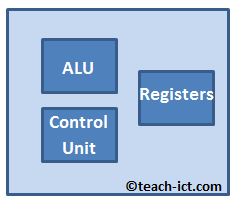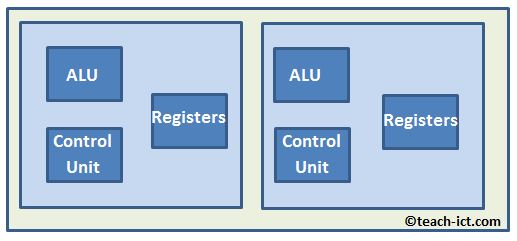CPU performance factors
3. Core
A 'core' is a complete processing unit within the CPU - it has an ALU, Control Unit and Registers

Originally there was only one processing core in a CPU. But as time moved on the processing core could be made even smaller, and around 2006 it became possible to put two cores inside a single CPU chip.

Now it is common for a CPU chip to have two, four, eight cores or more. A cpu with two cores is called a 'dual core' and one with four cores is called a 'quad-core'.
Increasing the number of cores improves performance in two ways.
Multi-tasking
Multi-tasking is the ability to carry out more than one task at the same time.
Clearly, with two cores, a CPU can run two tasks simultaneously.
A quad core can handle four simulateous tasks. So for example, one core could be running a photo editing application whilst another is handling a word processing application.
Parallel Processing
Parallel processing is when a single task (program) is split into two or more parts and each part is processed at the same time.
In theory this would double performance on a dual core cpu as each part is processed independently.
However, you do not always get twice the performance because many programs cannot be split neatly into two independent parts. This is because they are mostly sequential i.e. each task depends on the outcome of a previous task and so it has to wait for the first task to be completed.
An example where parallel processing is possible is a task to update all the pixels on the screen. The colour of one pixel does not tend to depend on another pixel.
